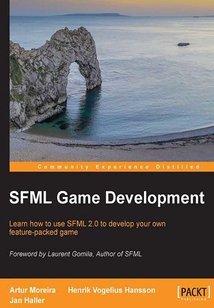舉報 

會員
SFML Game Development
最新章節:
Index
SFMLGameDevelopmentisafast-paced,step-by-stepguide,providingyouwithalltheknowledgeandtoolsyouneedtocreateyourfirstgameusingSFML2.0.SFMLGameDevelopmentaddressesambitiousC++programmerswhowanttodeveloptheirowngame.Ifyouhaveplentyofideasforanawesomeanduniquegame,butdon’tknowhowtostartimplementingthem,thenthisbookisforyou.ThebookassumesnoknowledgeaboutSFMLorgamedevelopment,butasolidunderstandingofC++isrequired.
目錄(85章)
倒序
- 封面
- 版權信息
- Credits
- Foreword
- About the Authors
- About the Reviewers
- www.PacktPub.com
- Preface
- Chapter 1. Making a Game Tick
- Introducing SFML
- A few notes on C++
- Developing the first game
- Game loops and frames
- Displaying sprites on the screen
- Summary
- Chapter 2. Keeping Track of Your Textures – Resource Management
- Defining resources
- Resources in SFML
- A typical use case
- An automated approach
- Error handling
- Generalizing the approach
- Summary
- Chapter 3. Forge of the Gods – Shaping Our World
- Entities
- Rendering the scene
- Updating the scene
- The view
- Landscape rendering
- Composing our world
- Integrating the Game class
- Summary
- Chapter 4. Command and Control – Input Handling
- Polling events
- Getting the input state in real time
- Playing nice with your application neighborhood
- A command-based communication system
- Customizing key bindings
- Summary
- Chapter 5. Diverting the Game Flow – State Stack
- Defining a state
- The state stack
- The state context
- Integrating the stack in the Application class
- Navigating between states
- The loading screen – sample
- Summary
- Chapter 6. Waiting and Maintenance Area – Menus
- The GUI hierarchy the Java way
- Updating the menu
- The promised key bindings
- Summary
- Chapter 7. Warfare Unleashed – Implementing Gameplay
- Equipping the entities
- Creating enemies
- Adding projectiles
- Picking up some goodies
- Collision detection and response
- An interacting world
- Victory and defeat
- Summary
- Chapter 8. Every Pixel Counts – Adding Visual Effects
- Defining texture atlases
- Low-level rendering
- Particle systems
- Animated sprites
- Post effects and shaders
- Summary
- Chapter 9. Cranking Up the Bass – Music and Sound Effects
- Music themes
- Sound effects
- Sounds in 3D space
- Summary
- Chapter 10. Company Atop the Clouds – Co-op Multiplayer
- Playing multiplayer games
- Interacting with sockets
- Data transport
- Network architectures
- Creating the structure for multiplayer
- Working with the Server
- Taking a peek in the other end – the client
- Latency
- Cheating prevention
- Summary
- Index 更新時間:2021-08-13 17:11:26
推薦閱讀
- C#編程入門指南(上下冊)
- 信息可視化的藝術:信息可視化在英國
- Microsoft Dynamics 365 Extensions Cookbook
- C/C++算法從菜鳥到達人
- 數據庫系統原理及MySQL應用教程
- Learning SQLite for iOS
- STM32F0實戰:基于HAL庫開發
- C語言程序設計學習指導與習題解答
- Java Web程序設計任務教程
- Mastering Data Mining with Python:Find patterns hidden in your data
- 計算機應用基礎案例教程
- 智能手機APP UI設計與應用任務教程
- Python期貨量化交易實戰
- Android Sensor Programming By Example
- Python物理建模初學者指南(第2版)
- 計算機組裝與維護(第二版)
- Java基礎案例教程(第2版)
- Learning Puppet Security
- 深入解析WPF編程
- Drupal 7 Webform Cookbook
- Oracle DBA基礎教程
- JavaWeb整合開發實例精通:Struts+Hibernate+Spring
- HTML5技術與移動出版
- Python數據科學指南
- 碼農修行:編寫優雅代碼的32條法則
- Home Automation with Intel Galileo
- 微信小程序開發從入門到項目實踐
- Web開發技術:HTML、CSS、JavaScript
- C# 8.0本質論
- Building Machine Learning Systems with Python

